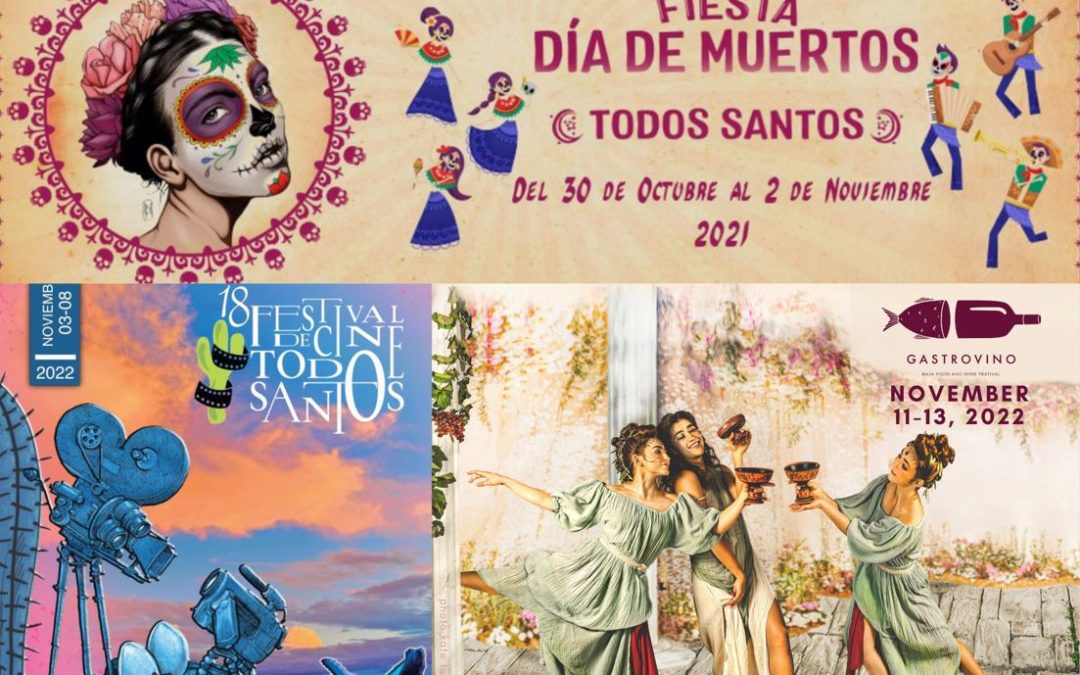
by Sonya Bradley | Arts & Culture, Blog, Conservation, Culture, Education, Food, Live Music Todos Santos, Places, Travel Industry
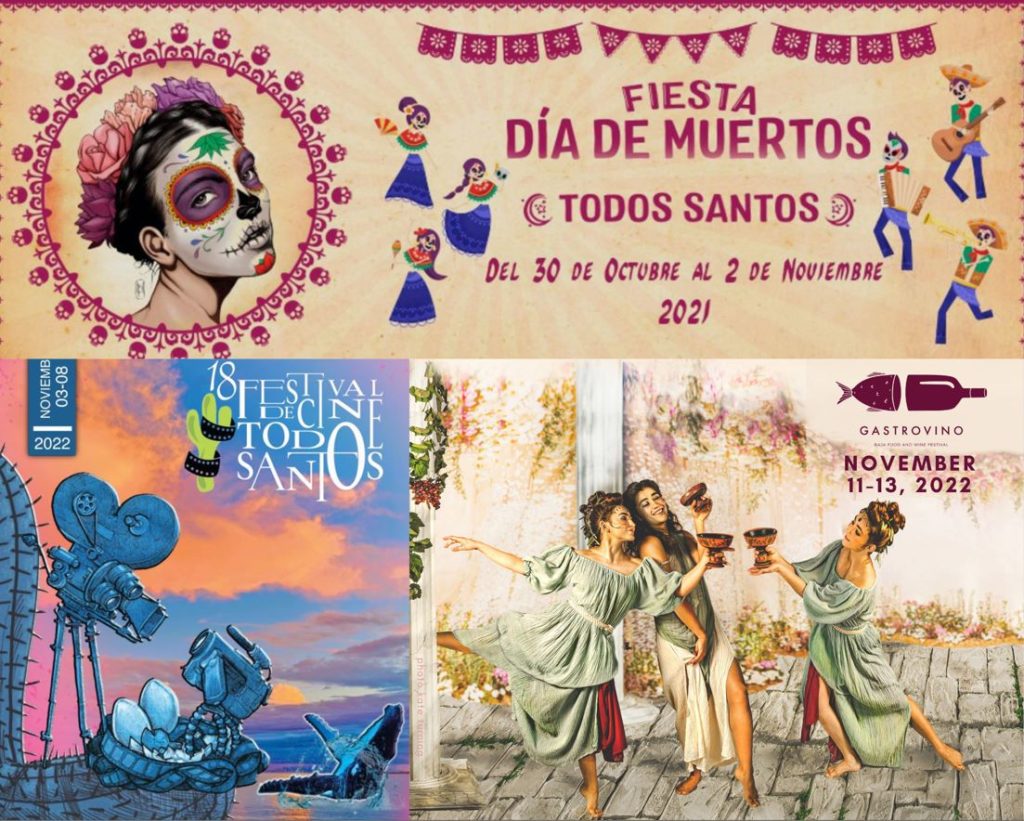
By Bryan Jáuregui, Todos Santos Eco Adventures
Todos Santos Eco Adventures and the Festivals of Todos Santos
No less an authority on the human condition than the Dalai Lama has proclaimed, “I believe that the very purpose of life is to be happy.” Helping to ensure that everyone in our community can fulfill that purpose, our three local masterminds of happiness – Rouss Ramirez, Sylvia Perel and Perla Garnica – are working to unleash a veritable avalanche of joy upon our pueblo magico. Check out this stellar calendar of bliss-inducing festivals that will start our season:
1. Day of the Dead Festival. Oct 30-Nov 2. 6th Anniversary. Rouss Ramirez
2. Todos Santos Film Festival. Nov 3-8. 18th Anniversary. Sylvia Perel
3. GastroVino Food & Wine Festival. Nov 11-13. 10th Anniversary. Perla Garnica
Todos Santos Eco Adventures, in conjunction with Alianza Cero Basura, is extremely proud to be partnering with these festivals, which bring their unique creative forces to bear in bringing about not just an isolated event, but fundamental, long-term community happiness. The festivals have long been committed to funding programs in education and healthcare to assist those in our community for whom such opportunities are not readily available. Now they are working to improve the way our community thinks about and deals with trash.
The Dalai Lama finished his thought on happiness by adding, “In my own limited experience I have found that the more we care for the happiness of others, the greater is our own sense of well-being.” So come out and enjoy these festivals, support your community, and know that your happiness will be spread throughout, helping to create a better future for us all.
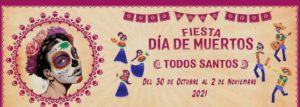
Rouss Ramirez and the Day of the Dead Festival.
Rouss and her store Besame Mucho Bazaar have been strong financial supporters of Alianza Cero Basura since the beginning, and this year Rouss is taking her commitment to zero waste principles one step further: all contestants in the main Catrin/Catrina contest of her Day of the Dead Festival must use repurposed materials to create their costumes! So take a fresh look at those yogurt containers, soup cans, wine bottles, potato chip bags and chewing gum wrappers and let your imagination run wild! All costume components will head to the recycling center afterwards. Rouss started the Day of the Dead Festival in 2017 with the founding of her nonprofit Amamos Nuestro Pueblo, AC (We Love Our Town AC). through which she supports children, the elderly and vulnerable people with serious illnesses in our community. Rouss has invested over 3 million pesos in her program.
 Sylvia Perel and the Todos Santos Film Festival.
Sylvia Perel and the Todos Santos Film Festival.
Since starting the Todos Santos Film Festival in 2004 Sylvia has become known for escorting famous movie stars and directors through Todos Santos. But her real passion has always been engaging local children in film making through her nonprofit, the AC Escuela de Cine Leonardo Perel (Leonardo Perel Film School), and teaching the power of film to address environmental issues. In 2019 she made Desplastificate the topic of her Cineminuto film competition, and students from across Baja California Sur submitted movies illustrating the importance of eliminating single-use plastics in our state. Next, she almost single-handedly produced Alice in the Land of the Whales, an environmental love letter to Baja California Sur, with local children both behind and in front of the camera. Other environmentally-themed films created by Sylvia’s local students include Open Sky, The Little Prince in Todos Santos and Trapiches de Todos Santos. This year the topic of her Cineminuto film competition is “Our Ocean, Our Treasure”, and again students from across the state are being invited to submit films on the importance of caring for the health of our oceans. The grand prize is a Go Pro 10. The Hollywood Foreign Press gave Sylvia a special award in 2018 for her festival’s focus on community and education.
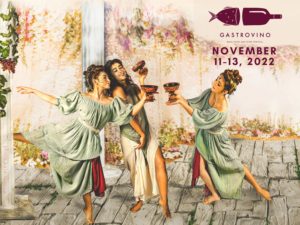 Perla Garnica and the GastroVino Baja Food and Wine Festival.
Perla Garnica and the GastroVino Baja Food and Wine Festival.
Perla created the GastroVino Festival in 2012 to celebrate Mexican wines and great local restaurants, and it has been a joyous affair every year since. To spread that happiness, the festival has always acted as a fundraiser for local nonprofits. Since 2012 it has donated USD $64,000 to key programs for the community including the Palapa Society and the Padrino Children’s Foundation. In 2019 Perla made the festival a single-use plastic free event, and this year Alianza Cero Basura, in conjunction with Water Ways Baja, will be providing water stations at the festival to ensure that no one feels compelled to bring in single-use plastic water bottles. Perla and the organizations she works with – Ricardo Amigo Real Estate and Plaza Amigos – have been key financial supporters of Alianza Cero Basura since the beginning, and installed the first public water bottle refill station for our community at Plaza Amigos.
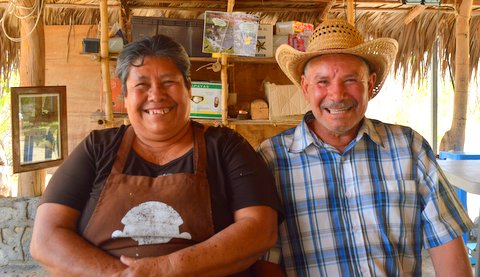
by Bryan Jáuregui | Culture, Places, Ranchero Culture, Travel Industry
By Bryan Jáuregui, Todos Santos Eco Adventures
This article first appeared in Janice Kinne’s Journal del Pacfico.
It takes a fair degree of faith in the goodness of your fellow man to hitchhike… with a mule. But that is exactly what Trudi Angell and her daughter Olivia did as part of La Mula Mil, their 1,000 mile mule trip up the Baja Peninsula. One of their mules had taken a respite with friends along the way, and when it came time for him to rejoin the rest of the expedition – now many miles away – Trudi and Olivia just set out along the road with him. Women and mule were picked up by a rancher with a partially empty horse trailer in a matter of minutes, and safely delivered to their camp. Says Trudi, “This was indicative of the type of reception we got from ranch families throughout the entire expedition. They were above and beyond hospitable and helpful. Wonderful meals for us, care for the mules, information on trails – they were generous to a fault with all these things.”
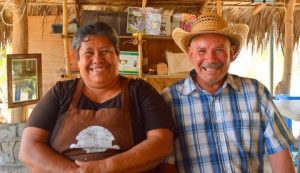
Doña Luz and Don Cata
Fermín Reygadas, a professor of Alternative Tourism at the Autonomous University of Baja California Sur (UABCS) who has worked with Baja California rancheros for over 30 years, is not at all surprised. “The Baja ranchero culture of hospitality is directly connected to the old Bedouin custom that demanded the utmost in hospitality, requiring you to give aid and succor to anyone who asked for it for at least 3 days, even if that someone was your mortal enemy. Of course, you were free to kill him after that, but for those 3 days he was an honored guest in your home.” Bedouins?
Fermín explains. “When Padre Kino first arrived with the Jesuits in Baja California in 1683, pirates were a menace to this new territory of Spain. Padre Kino sold the Spanish king on the idea of Jesuits settling the land and using their own money and means to keep it free of pirates. In return, the Jesuits would have the right to rule without interference from a Spanish-run civil government. The king agreed and the Jesuits set about recruiting soldiers that bore little resemblance to their European counterparts. They didn’t choose people based on their fighting or weaponry skills, but rather people who knew how to raise cattle and plant crops. They didn’t choose typical soldiers looking for new world get-rich-quick schemes, but people seeking a living from the land with a focus on family. The Jesuits chose people whom they considered honorable, trustworthy and capable to protect and settle Baja California Sur.” In short, they chose the people whose descendants make it possible for women to successfully hitchhike around the peninsula with a mule. We’re getting to the Bedouins.
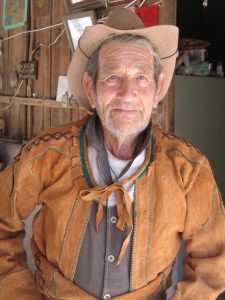
Miguel Martinez. Photo by McKenzie Campbell, Living Roots
Fermín continued, “When the Jesuits arrived in Baja California the indigenous peoples here were hunter-gatherers, skills not suited to building a permanent society. So the Jesuits looked for people who had the ranching and farming skills that could support their missions. These people came from two main sources: 1) people from the agricultural province of Andalusia in Spain, which had been heavily settled by Moors, Arabs and Middle Easterners during the Moorish conquest of Spain in the 8th to 15th centuries, and 2) descendants of the Moors, Arabs and Jews who had been kicked out of Spain during the 15th century Christian reconquest of the country, and had settled in the new world. Not only did these “soldiers” carry the Bedouin tradition of hospitality and honor, they brought Middle Eastern foods to the Baja Peninsula that still flourish to this day including olives, grapes, lentils, date palms and alfalfa.” Teddi Montes, a member of La Mula Mil expedition, took DNA samples from rancheros throughout the trip and her preliminary results show that these middle eastern bloodlines are still found throughout the peninsula, i.e., the Bedouins – along with their hospitality – are alive and well in Baja California!
Ranchero Rule in BCS
The Jesuits ended up being entirely too successful for their own good with their BCS economic model, and they were unceremoniously kicked out of Baja in 1768. The king sent a new administrator who gave the Jesuit mission lands to the “soldiers” who had been working the land under the Jesuits. By this administrative fiat a whole new class of fairly egalitarian land ownership arrived in BCS, and a system of ranches owned and operated by people with excellent skills, a strong work ethic, and a tradition of honor flourished. This was in stark contrast to mainland Mexico, which was heavily settled by Spanish hidalgos, the 2nd, 3rd and 4th sons of wealthy marquis who could not inherit the ancestral lands back home, but who could help themselves to substantial holdings in the new world. “Work ethic” was not a phrase commonly used when speaking of the privileged hidalgos.
By the late 1800s the Baja economy had become centered around mining, with major gold, silver and copper mines flourishing in towns like Santa Rosalia
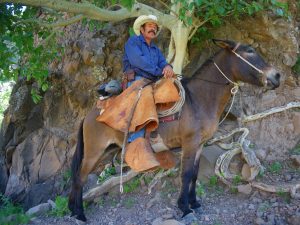
Chema. Photo by McKenzie Campbell, Living Roots
and El Triunfo. As mining prospered, so did the ranches that supplied them with food, leather goods, horses, mules, and coffee. Mainland Mexico, focused on its own affairs – including wars with the US and France – paid very little attention to Baja for the next 100 years. The result was that the BCS character cultivated by the Jesuits and strengthened by land ownership was left intact, and continued to develop almost completely independently of the rest of Mexico. While mainland Mexico society became highly stratified, Baja California remained a much more egalitarian, independent-minded place, with ranchero families a key and integral part of the peninsula’s economy.
Then mining collapsed in the 1950s, and the ranchero economy went into a tailspin. But the deathblow really came in 1975 when the Mexican government opened its previously closed economy to the outside world. Two territories were declared free ports open to foreign trade: Quintana Roo and BCS. Almost overnight the market for ranch meats, cheeses and leather goods dried up; imported goods could be bought more cheaply and easily in the cities. Ranchero culture was in peril, and made all the more precarious by a school system that requires ranch children to leave home for 9 years and live in boarding houses in towns like Todos Santos, where they steadily lose touch with their culture. As Fermín says, “They watch a lot of TV in the boarding houses, and if their culture doesn’t appear on TV, then they assume it’s not important.” Fermín, Trudi, Olivia and others are trying very hard to change that perception.
Living Roots
In 2008 a documentary titled Corazon Vaquero – Heart of the Cowboy – won the Paso Robles Film Festival California Roots award. Created by Garry and Cody 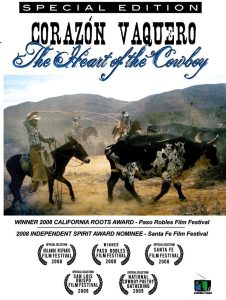 McClintock and Eve Ewing with Trudi, Fermín and others to showcase the beauty of BCS ranchero culture, the film is centered largely around a family at Rancho San Gregorio in the Sierra de la Giganta above Loreto. In the spring of 2008 a young NOLS instructor named McKenzie Campbell found herself at that same ranch. “I learned how to do leatherwork, make cheese, all kinds of things. I was completely enamored. I then did a week-long scouting trip through the Sierra de la Giganta walking ranch to ranch, and I was completely blown away by the hospitality of the people and their values. They are focused on family, their land and working hard for themselves. They don’t need a lot to be happy. They inspired me to go back to school to get the tools to aid them in the transition to the modern world, to participate in the larger market around them.”
McClintock and Eve Ewing with Trudi, Fermín and others to showcase the beauty of BCS ranchero culture, the film is centered largely around a family at Rancho San Gregorio in the Sierra de la Giganta above Loreto. In the spring of 2008 a young NOLS instructor named McKenzie Campbell found herself at that same ranch. “I learned how to do leatherwork, make cheese, all kinds of things. I was completely enamored. I then did a week-long scouting trip through the Sierra de la Giganta walking ranch to ranch, and I was completely blown away by the hospitality of the people and their values. They are focused on family, their land and working hard for themselves. They don’t need a lot to be happy. They inspired me to go back to school to get the tools to aid them in the transition to the modern world, to participate in the larger market around them.”
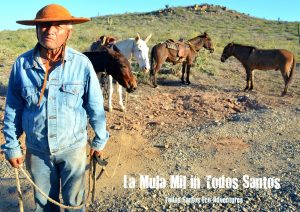
Carlos Ignacio (Nacho) Chiapa with La Mula Mil in Todos Santos
Two years and one MBA later, McKenzie returned to BCS and founded Living Roots, a non-profit with the mission of “Helping an endangered culture adapt and thrive in the modern world.” Focusing on San Javier, the site of one of the Jesuits’ very first missions in BCS, McKenzie set about walking the delicate line between protecting ranchero values and traditions, while connecting ranchero families directly to the marketplace. “They grasped immediately that they had a brand-able concept, but they didn’t see that some of their every day items like ropes and jackets had market value, and we were able to help them see and capture some of that value.” In 2013 Living Roots helped the rancheros establish a cultural center in San Javier that connects them directly with their public. Not only does this place serve as a market for ranch products, but it’s now the base station for many young rancheros who are being trained as guides in order to lead interpretive hikes around the area. In 2014 Living Roots and its ranchero partners also started a farmer’s and artisan’s market in Loreto that sells organic produce, fish and handicrafts. Says McKenzie, “The US and Canadian communities who live in Loreto are hungry for local produce so it’s been quite successful. It is wonderful to see it all progressing so well.”
McKenzie’s next goal for Living Roots is to start a school for young rancheros aged 15-25 where they can learn the old technologies and merge them with the new. Courses are already underway in some schools, with living legends like Dario Higuera, featured prominently in Corazon Vaquero, teaching traditional leatherwork to kids in the local schools. The most popular items to make are wallets and cell phone covers.
Into the Future
35 year-old Rogelio Rosas knows the value of learning traditional skills from his ranching elders. As a child he lived with his grandparents on the family ranch in San Dionisio in the Sierra de la Laguna mountains. Every day he would work alongside his grandfather, learning how to identify and use the 80 edible wild
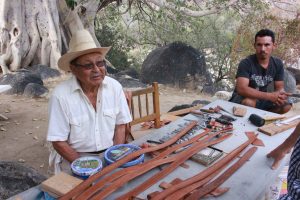
Don Claudio teaching leatherwork. Photo by Eduardo Boné
plants that grow in BCS, including those with medicinal properties. By the time he was 10 he was helping his grandfather deliver babies and heal the sick throughout the area. When his grandfather died at the age of 116 (leaving 35 children fathered with 5 wives) Rogelio felt compelled to enroll at a seminary in Tijuana. But he didn’t find the answers he expected there, so he joined up with some missionaries and spent the next 6 years traveling throughout Baja, using the healing arts learned from his grandfather to help children around the peninsula.
Rogelio found this work rewarding, but he still wasn’t finding the answers he was seeking. So at the age of 28 he moved to La Paz to study philosophy at UABCS, the first member of his family to attend college. While there, he met McKenzie and Fermín who were in the alternative tourism arena, so he added tourism to his list of degrees. By this time Rogelio’s parents, the now-legendary Don Catarino and Doña Luz, had been living at the family ranch for many years, making a very nice living with their organic produce, leather work and other traditional skills. When Doña Luz suffered a snake bite that paralyzed half her body, Rogelio returned to the ranch where he had grown up to help her. By the time he graduated with his double degree from UABCS, he could have joined the majority of his ranching peers and gone off to seek employment in a shinier part of the economy. But he found the pull of the ranch impossible to resist, and is now working with his parents to develop their ranch as a tourist destination where visitors can learn about traditional crafts like leatherworking and cheese-making, hike to see waterfalls and rock art, learn about traditional medicinal herbs, make tortillas from scratch, and enjoy the
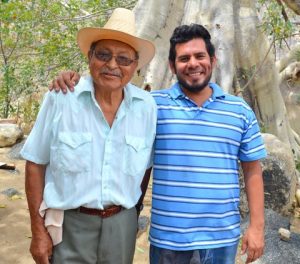
Don Claudio and Rogelio
history and culture of the area. This is the future that he sees that will sustain not only his family’s ranch, but those of other families throughout the region.
But like Fermín, Trudi and McKenzie, Rogelio’s real passion is to preserve the heart and soul of ranchero culture. To that end he has created a document that sets forth the principals and values of ranchero life. Working with seven other sons of ranchers who, like him, left home for a while but then returned, he is in the process of creating an association that will keep the rancheros of the Sierra de la Laguna mountains united and focused, adapting to a changing world economy as necessary to thrive, but doing so while maintaining the values and ethics of their forebears, handpicked by the Jesuits. The goal is to remain true to their Bedouin roots. You can count on their hospitality.

by Bryan Jáuregui | Homepage, Wildlife
by Bryan Jáuregui, Todos Santos Eco Adventures
This article was originally published in Janice Kinne’s Journal del Pacifico

Blue-footed Boobies at Isla La Gaviota in the Sea of Cortez. Photo by Colin Ruggiero
At a time when over half the single people in the Americas have created an online dating profile through which they send out their virtual avatars to court potential partners, it may be difficult to remember the days of Saturday Night Fever and Strictly Ballroom when plumage and dance moves were everything. But off the coast of Baja California Sur on islands like La Gaviota, Isla Isabel, and Isla San Pedro Mártir, dancing to show off mating suitability is alive and well, although the practitioners looked so silly to early outside observers that they earned themselves the name of Booby, from the Spanish word bobo meaning “stupid” or “clown”. Pretty much your worst dancing-in-public nightmare.
But the Blue-footed Boobies of Baja remain unruffled, secure in the knowledge that shaking their tail feathers has resulted in what is possibly the largest Blue-footed Booby colony in the world. And it’s not just the moves that are important in their dance, but the exact cerulean hue the footwork displays. Blue-footedness, it turns out, is enhanced by the bright yellow pigments found in the carotenoids of the fish the birds consume, so those who catch and eat more fish get bluer feet. Ipso facto bluer feet connote better health, better health connotes greater ability to provide for a nest, and as every dancer in life thinking about raising a chick knows, those are the moves that really count in a mate. So the booby dance includes a series of steps in which the feet are raised up to allow potential partners to inspect their blue-ness (apparently a vibrant aquamarine is the most desirable) and determine if that’s the blue they want to get tangled up in. And unlike in some species in which only the male sports the color, in boobies both sexes are focused on the blue tones of a potential partner’s feet. In fact, males will avoid mating with females whose blue feet have been dulled with paint. With boobies, it definitely takes two to tango.

Blue-footed Boobies. Photo by Colin Ruggiero
And in many cases, three. Researchers have found that Blue-footed Booby rookeries could easily provide source material for the most salacious telenovelas; in over 50% of booby couples one or both partners engage in what scientists call extrapair behavior (what the rest of us would call an extramarital affair), and it is not at all uncommon for a booby to toddle off for a quickie with the neighbor while its mate is out foraging at sea. Dr. Hugh Drummond, Professor of Biology at the National Autonomous University of Mexico (UNAM), who has studied the Blue-footed Boobies at Isla Isabel for the last 37 years, notes his education on this point. “There was a time when we thought that all bird species were monogamous and mated for life. This couldn’t be further from the truth. The majority of studies indicate extra pair behavior in birds. This is not surprising in males as this behavior can provide them with extra offspring at no cost. What is surprising is that in the vast majority of bird species, including the Blue-footed Booby, the females stray. It’s surprising because this behavior can be accompanied by some fairly high costs.”
Scientists, being scientists, have been searching for a rationale for the female booby’s lustful leanings as “because she can” doesn’t square in a world in which behaviors are generally explained by survival and advancement of the gene pool. The working hypothesis was that a female who is nest hopping with the neighbors must be doing so because she is not paired with the ideal biological partner, and is therefore driven to hook up with a better set of genes. But, as Dr. Drummond notes, “Most studies have found no difference in the success of the mated pair’s offspring versus the success of the extra pair’s offspring. The extra pair males have not consistently proven to provide better genes than those of the mates. So we have to consider that the female’s behavior may not be for the benefit of the offspring after all.” Have female boobies liberated themselves from the Darwinian grind?

Blue-footed Booby in the Sea of Cortez. Photo by Colin Ruggiero
Possibly, but the males aren’t taking it lying down. They will destroy an egg in their nest if they suspect it was fertilized by another, and if the female was out of their observation range for a few hours or more during the 5 days of fertility prior to egg laying, then they are definitely suspicious. Dr. Drummond and his colleagues tested this by “kidnapping” males during the 5 critical days. Under these circumstances, the males destroyed the first egg subsequently laid, ensuring that they didn’t have to raise some other guy’s chick. If they are kidnapped prior to the fertile period they leave the egg alone. Male boobies will actually abandon particularly perfidious partners, and seek out others to soothe their ruffled feathers. Says Dr. Drummond, “Isla Isabel has roughly 2,000 pairs of Blue-footed Boobies, and at the end of every season half of the pairs break up.”
Before egg incubation starts, nearly all male boobies on Isla Isabel court extra pair females, while roughly one third of the females develop sexual relationships with one or more male neighbors. But booby mates who retain the same partner for successive years definitely reap gene pool rewards – Dr. Drummond has found that they produce 35% more offspring those who change partners. And while all booby couples share in parental duties, longtime mates spend equal time caring for their young. They are completely in it together, with males spending just as much time as their mates on household duties. Female boobies. Has their behavioral long game all along been shaping male boobies into the perfect domestic partner? That would be a remarkable evolutionary feat!
While longtime mates may cohabit harmoniously, harmony is definitely not a word one would associate with their offspring in the nest. Dr. Dave Anderson, Professor of Biology at Wake Forest University, has studied boobies in the Galapagos Islands for most of his adult life. He explains. “Nazca boobies (the Blue-foot’s cousin) only want one chick but they sometimes have two by mistake when their extra insurance egg hatches. In such cases, 100% of the time the older (or healthier) chick will force the other one out of the nest with no parental interference, and perhaps even some parental facilitation. Once out of the nest, a chick has no way to survive on its own. Nazca boobies nest on the ground in such a way that the nest is essentially a gladiatorial arena that the parents observe from on high.”
“The Blue-footed Boobies, on the other hand, do want the option of having two chicks. So they will give the first egg a head start of 3-5 days before laying the second egg, such that a natural dominance hierarchy is established among the resulting chicks. If food is abundant, they will raise both chicks. However, the first-hatched chick fiercely beats up the second-hatched, and the second-hatched survives only by adopting submissive behavior.” Dr. Anderson points out that the parents help the subordinate by building nests that are bowl-shaped, which means that when the older chick is pecking the younger one, at least for the first ten days or so, the poor little guy generally doesn’t fall out of the nest like its hapless Nazca counterpart – there are walls to keep it hemmed in. Further, unlike the murder-permissive Nazcas, murder-restrictive Blue-footed Booby parents will actually sit on their chicks to prevent the dominant from killing the subordinate.
Dr. Anderson tested what would happen when the constraints of the parents and the bowl-shaped nest are removed. “What is really interesting,” says Dr. Anderson, “is when we put Blue-footed Booby chicks in Nazca nests with Nazca parents. They are much more aggressive than when in their own nests. And when we put Nazca chicks in Blue-footed nests with Blue-footed parents, they still want to kill each other but can’t because of the shape of the nest and the murder-restrictive Blue-footed parents.” They may fool around like mad, but the Blue-footed Boobies do draw the line at siblicide, unless of course, food is scarce – as in an El Niño year – and subordinate chick sacrifices must be made.

Blue-footed Boobies. Photo by Colin Ruggiero
Now you may well imagine that the poor second-hatch chicks, having been so horribly abused by their siblings and practically starved to boot, would turn into physically stunted adults, emotionally crippled by their circumstances and consigned to a lifetime of failure. “Not so!” says Dr. Drummond. “We compared 1,167 fledglings of two-chick broods for 10 years and found few differences between first-hatched and second-hatched birds. Even more surprisingly, where there were differences these tended to favor subordinates.” By almost every measure that counts in a booby’s biological life, Dr. Drummond found that the subordinate chicks matched or bettered those of their dominant tormenters including survival, defensive ability, brood size, nest success, and cumulative brood size over the first ten years of life. Blue-footed Boobies. Liberated females, progressive males, bullies not allowed to flourish over others. What else can we learn from our blue-footed friends?
Every mating season the Blue-footed Booby males stake out their territories and wait for females to come by and notice them. “The males then fall all over themselves trying to demonstrate their suitability as a mate” says Dr. Drummond. One would think in such circumstances that younger, more virile (and of course bluer-footed) birds, would rule the day. But once again, things are not always as one would imagine in the booby world. Dr. Drummond and his colleagues have found that May-December romances among the boobies, i.e., partnerships in which one bird is old and one bird is young, produce offspring that are significantly more likely to later become parents themselves compared to the offspring of parents of a similar age. And it doesn’t seem to matter which sex is at which end of the age spectrum, old mothers and young fathers or old fathers and young mothers, the results were the same in the 3,361 booby offspring that Dr. Drummond and his colleagues studied – breeding in age-mismatched parents provides greater success in contributions to the gene pool than those of similarly aged parents. In fact, the advantage to the chicks born of May-December parents was almost as great as those conferred on chicks whose parents are in long-term partnerships. Why this is so remains a scientific mystery. Could it simply be that Blue-footed Boobies are as socially evolved as the French?
So now we know that these dancers who looked so silly they earned themselves the name of Booby may actually have some elegant lessons to share across species: 1. A rough start in life need not define your later years; 2. Sharing equally with a long-term partner produces better health for the family; 3. Age does not necessarily define your ability to contribute to society; and 4. Dancing your heart out no matter what you look like to strangers is one of the keys to a successful life. In fact, the future of the species depends on it.
© Copyright Sergio and Bryan Jauregui, Casa Payaso S de RL de CV, 2017



 Sylvia Perel and the Todos Santos Film Festival.
Sylvia Perel and the Todos Santos Film Festival. Perla Garnica and the GastroVino Baja Food and Wine Festival.
Perla Garnica and the GastroVino Baja Food and Wine Festival.




 McClintock and Eve Ewing with Trudi, Fermín and others to showcase the beauty of BCS ranchero culture, the film is centered largely around a family at Rancho San Gregorio in the Sierra de la Giganta above Loreto. In the spring of 2008 a young NOLS instructor named McKenzie Campbell found herself at that same ranch. “I learned how to do leatherwork, make cheese, all kinds of things. I was completely enamored. I then did a week-long scouting trip through the Sierra de la Giganta walking ranch to ranch, and I was completely blown away by the hospitality of the people and their values. They are focused on family, their land and working hard for themselves. They don’t need a lot to be happy. They inspired me to go back to school to get the tools to aid them in the transition to the modern world, to participate in the larger market around them.”
McClintock and Eve Ewing with Trudi, Fermín and others to showcase the beauty of BCS ranchero culture, the film is centered largely around a family at Rancho San Gregorio in the Sierra de la Giganta above Loreto. In the spring of 2008 a young NOLS instructor named McKenzie Campbell found herself at that same ranch. “I learned how to do leatherwork, make cheese, all kinds of things. I was completely enamored. I then did a week-long scouting trip through the Sierra de la Giganta walking ranch to ranch, and I was completely blown away by the hospitality of the people and their values. They are focused on family, their land and working hard for themselves. They don’t need a lot to be happy. They inspired me to go back to school to get the tools to aid them in the transition to the modern world, to participate in the larger market around them.”






